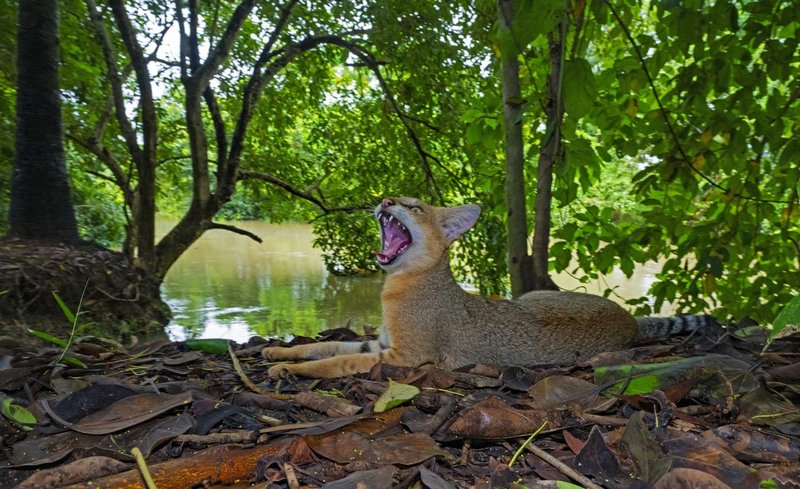
Imagine you’re in a vibrant rainforest, the sun filtering through the leaves, and suddenly, a jungle cat appears out of nowhere. First of all, it’s important to understand that these creatures, while beautiful, can be unpredictable. But don’t worry; being prepared can make all the difference. Let’s break down what you should do if you come across one of these wild cats, ensuring you stay calm and safe.
Stay Calm and Assess the Situation
When you spot a jungle cat, the first thing to do is take a deep breath. It’s easy to let panic set in, but staying calm is vital. Look around and assess your surroundings. Are there any obstacles between you and the cat? Is it aware of your presence? Usually, they’re just as curious about you as you are about them. Remember, they don’t see us as prey, but that doesn’t mean they won’t defend themselves if they feel threatened.
Next, try to gauge the cat’s behavior. Is it stalking, lounging, or simply observing you? If it’s showing signs of aggression, like hissing or growling, it’s best to keep your distance. Think of it as being in a dance; you wouldn’t want to step on the toes of a partner who’s clearly uncomfortable. So, give the jungle cat space and respect its territory.
Back Away Slowly
If it does feel like you’re in a standoff, the best way to handle it is to back away slowly. Sudden movements can startle the animal, which might trigger a defensive response. So, think of it like a slow-motion retreat—keep your body relaxed, and avoid turning your back to the cat. You wouldn’t want to turn a fun encounter into an awkward situation, right?
Take small steps backward, keeping your eyes on the cat. This way, you’re still aware of its movements, and it knows you’re not trying to challenge it. Remember, giving it space is key. Each step you take should be deliberate and careful, just like walking on eggshells. This approach reduces the chance of scaring the cat, allowing it to feel secure enough to wander away.
Make Yourself Appear Larger
Honestly, if you find yourself in the presence of a jungle cat, making yourself look larger can help in some cases. Raise your arms, open your jacket, or whatever you can do to appear bigger. It’s kind of like puffing up your chest to show confidence without being aggressive. This display may deter the cat from approaching you, as it won’t see you as an easy target.
However, do this gently; the goal isn’t to frighten the cat but to assert your presence. If the cat perceives you as a non-threat, it’s likely to lose interest and move along. Think of it as a peacock showing its feathers—only use it if necessary.
Use a Firm and Calm Voice
If the cat continues to approach, using a steady, firm voice can also be helpful. A simple “Hey!” or “Go on, now!” in a calm tone can be effective. This is about asserting your space without coming across as aggressive. Instead of yelling, which might startle the cat, keep your voice steady and confident.
Here’s the thing: cats, including jungle cats, often respond to the tone of voice. It’s not about what you say, but how you say it. Your aim is to communicate that you’re not a threat while also making it clear that you’re standing your ground. Just like talking to a friend in a calm manner, this approach helps defuse the situation without raising alarms.
Leave the Area if Necessary
Sometimes, despite your best efforts, the cat may stay put. If you find that the situation isn’t resolving itself, it might be time to leave the area. It’s not a sign of defeat; rather, it’s a smart move. Just like you wouldn’t linger in an uncomfortable conversation, stepping away is sometimes the best option.
When leaving, continue to back away slowly, maintaining eye contact until you’re a safe distance away. Once you feel secure, you can turn and walk away without running. This is key because running might trigger a chase instinct in the cat.
Report the Encounter
If you’ve come across a jungle cat in the wild, it’s good practice to report your encounter. This is especially important if you’re in a protected area or a national park. Informing park rangers or local wildlife authorities helps them monitor wildlife activity and ensure public safety.
Sharing details about your encounter can also provide helpful data for conservation efforts. For instance, if the cat is behaving unusually—like being too familiar with humans—it could indicate that something needs to change in the area to protect both the animals and people.
Learn About Jungle Cats
Finally, educating yourself about jungle cats and their behavior can make a huge difference. Understanding their habits, territory, and diet helps demystify these incredible animals. The more you know, the better prepared you’ll be if you ever find yourself in their midst.
Jungle cats are primarily solitary hunters who thrive in various environments, from grasslands to forests. They play a pivotal role in their ecosystems by controlling the populations of smaller animals. Learning about their behavior not only enriches your outdoor experiences but also fosters a deeper respect for wildlife.
Final Thoughts
Encountering a jungle cat in the wild can be an unforgettable experience, filled with wonder and a bit of fear. By keeping a calm demeanor, backing away slowly, and making yourself appear larger, you can navigate the encounter safely. Always remember to respect these magnificent creatures and their space. Nature has a way of surprising us, but being prepared helps us appreciate its wonders while staying safe. So, whether you’re hiking, camping, or simply enjoying the great outdoors, understanding these creatures and knowing what to do can turn a potentially tense situation into one of admiration for the beauty of the wild.

